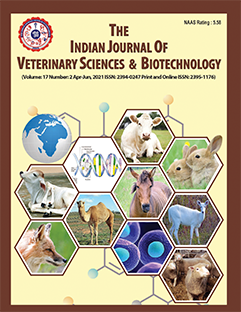First Report of a Nematode Pterygodermatites affinis Parasitizing a Stray Cat (Felis catus) from North India
DOI:
https://doi.org/10.48165/ijvsbt.21.6.39Keywords:
Felis catus, Nematode, Pterygodermatites affinis, Spirurida, ZoonoticAbstract
The genus Pterygodermatites (Order: Spirurida, Family: Rictulariidae) represents a group of spirurid nematodes known for their complex life cycles and wide host range among terrestrial vertebrates. These nematodes are primarily intestinal parasites of small mammals, with the majority of species infecting rodents and insectivores (Anderson et al., 2009). Occasional infestations have also been reported in carnivorous hosts, including wild canids and felids, although such occurrences remain relatively rare. Transmission of Pterygodermatites spp. follows an indirect life cycle involving arthropod intermediate hosts typically cockroaches or beetles which ingest embryonated eggs and in turn are consumed by the definitive mammalian host (Yue et al., 1986; Sundar et al., 2023). While the genus has a cosmopolitan distribution, most documented infections in felids are restricted to regions in Europe and North Africa (Feliu et al., 1997). In felines, infections are often under-diagnosed due to the cryptic nature of parasitism, limited veterinary care for stray animals, and a general lack of targeted parasitological surveillance. Stray cats, in particular, occupy a unique ecological niche. Often unmanaged and lacking routine veterinary attention, they serve as potential reservoirs and transmission agents for a variety of helminth parasites, some of which may pose risks to human and animal health (Alho et al., 2017; Khedri et al., 2024). In India, while several studies have documented the presence of gastrointestinal helminths in stray cats, infections with Pterygodermatites spp. have remained unreported. The absence of previous records may be attributed to limited diagnostic resolution, lack of comprehensive morphological examinations, or true absence of this nematode in local cat populations. The present study fills this gap by documenting, for the first time, the presence of Pterygodermatites affinis in a stray domestic cat (Felis catus) from Mathura, a semi-urban region in northern India characterized by a high density of free-roaming animals and poor waste management. This report contributes new data to the parasitological record, extending both the host range and geographical distribution of P. affinis, and highlights the urgent need for integrated, One Health-based parasitic surveillance in urban and peri urban environments.
Downloads
References
Alho, A.M., Lima, C., Colella, V., Correia, J.J., Lóia, F., de Carvalho, L.M., & Otranto, D. (2017). Prevalence of gastrointestinal parasites in stray cats in the metropolitan area of Lisbon, Portugal. Journal of Feline Medicine and Surgery, 19(5), 436–441.
Anderson, R.C., Chabaud, A.G., & Willmott, S. (2009). Keys to the Nematode Parasites of Vertebrates (Archival Volume). CABI Publishing, Wallingford, UK.
Baruš, V., Petavy, A.F., Deblock, S., & Tenora, F. (1996). On Pterygodermatites (Multipectines) affinis and other species of Multipectines (Nematoda: Rictulariidae). Helminthologia, 33(2), 93–100.
Bouzid, M., Halai, K., Jeffreys, D., & Hunter, P.R. (2013). The prevalence of zoonotic gastrointestinal parasites in urban and peri-urban environments: A systematic review and meta-analysis. International Journal for Parasitology, 43(12–13), 901–911.
Bowman, D.D. (2020). Georgis’ Parasitology for Veterinarians (11th ed.). Elsevier.
Erol, U., Sarimehmetoglu, O., & Utuk, A.E. (2021). Intestinal helminths of red foxes and molecular characterization of Taeniid cestodes. Parasitology Research, 120(8), 2847–2854.
Feliu, C., Renaud, F., Catzeflis, F., Hugot, J.P., Durand, P., & Morand, S. (1997). A comparative analysis of parasite species richness of Iberian rodents. Parasitology, 106(5), 527–533.
Hoppe, E.G.L., Lima, R.C.A., Tebaldi, J.H., & Nascimento, A.A. (2010). Pterygodermatites (Multipectines) pluripectinata n. sp. from the crab-eating fox Cerdocyon thous. Journal of Helminthology, 84(3), 312–316.
Khedri, J., Sharifdini, M., Gholami, S., & Tavassoli, M. (2024). Helminth infections in stray cats: A case study from northern Iran. Veterinary Parasitology: Regional Studies and Reports, 47, 100853.
Lahmar, S., Boufana, B., Boubaker, S.B., & Landolsi, F. (2014). Intestinal helminths of golden jackals and red foxes from Tunisia. Veterinary Parasitology, 204(3–4), 297–303.
Reyes-Canul, M.A., González-Solís, D., & Torres-Castro, M. (2024). Emerging zoonotic parasites at the urban-wildlife interface: A One Health perspective. Parasites & Vectors, 17(1), 1–11.
Scioscia, N.P., Navone, G.T., & Robles, M.R. (2016). New host records and distributional expansion of Pterygodermatites in wild canids from the Amazon biome, Brazil. Parasitology Research, 115(7), 2661–2667.
Sundar, S.T.B., Ramanujadas, T., Kavitha, K.T., Ravi Latha, B., Nishanth, B., Palanivelrajan, M., & Sridhar, K. (2023). Pterygodermatites cahirensis in palm civet cat (Paradoxurus hermaphroditus): A case report. Indian Journal of Veterinary and Animal Sciences Research, 52(2), 122–128.
Yue, D.M., Li, X.X., & Yang, Y.L. (1986). Life cycle of Pterygodermatites (Paucipectines) affinis in the cat. Acta Zoologica Sinica, 32(1), 90–95.
Downloads
Published
Issue
Section
License
Copyright (c) 2025 Indian Journal of Veterinary Sciences and Biotechnology

This work is licensed under a Creative Commons Attribution-NonCommercial-NoDerivatives 4.0 International License.




